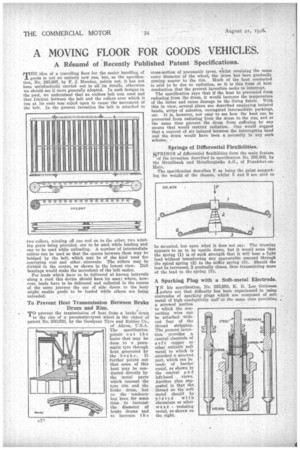A MOVING FLOOR FOR GOODS VEHICLES.
Page 34

If you've noticed an error in this article please click here to report it so we can fix it.
A Resuind of Recently Published Patent Specifications.
MHE idea of a travelling floor for the easier handling of goods is not an entirely new one, but, as the specification, No. 293,997, by F. J. Munday, points out, it has not been satisfactorily carried out in all its details, otherwise we should see it more generally adopted. In such designs in the past, we understand that an endless belt was used and that friction between the belt and the rollers over which it ran at its ends was relied upon to cause the movement of the belt. In the present invention the belt is attached to two rollers, winding off one and on to the other, two winding gears being provided, one to be used while loading and one to be used while unloading. A number of intermediate rollers can be used so that the spaces between them may be bridged by the belt, which may be of the kind used for conveying coal and other, minerals: The rollers may be divided in the centre, as shown in the lowest view. Dail bearings would make the moverkent of the belt easier. For loads which have to be delivered at known intervals along a road this device should have its uses; where, however, loads have to be delivered and collected in the course of the same journey the use of side doors to the body might enable goods to be loaded while others are being unloaded.
To Prevent Heat Transmission Between Brake Drum and Rim.
TG prevent the transmission of heat from a brake''drum to the rim of a• pnentaatic-tyred wheel is the object of patent No. 280,920, by the Goodyear Tyre and Rubber Co., of • Akron, U.S.A. The specification points out the harm that may be done to a pneumatic tyre through heat generated by the brake. It further points out that some of this heat may be conducted directly by the metal parts which connect the tyre rim and the brake drum, but as the tendency has been for some time to inereasil the diameter of brake drums and to increase the c:5')
cross-section of pneumatic tyres, w.hilst retaining the same outer diameter of the wheel, the drum has been gradually coming nearer te the rim. Much of the heat conducted is said to be due to radiation, so it is this form of heat conduction that the present invention seeks to interrupt. The specification says that if the heat be prevented from radiating from the drum, it 'would increase the temperature of the latter and cause damage to the lining fabric. With this in view, several plans are described employing isolated bands, strips of asbestos, corrugated intermediate packings, etc. It is, however, not easy to see how the heat can be prevented from radiating. from the drum to the rim, and at the same time prevent the drum from suffering by any means that would restrict radiation. One would suggest that a current of air induced between the intercepting band and the drum would have been a necessity in any such scheme.
Springs of Differential Flexibilities.
SPRINGS of differential flexibilities form the main feature of the invention described in specification No. 285,809, by the Metallbank und Metallurgische A.G., of Frankfort-onMain.
The specification describes P as being the point supporting the weight of the chassis, whilst 5 and 6 are said to he mounted, but upon what it does not say. The drawing appears to us to be upside down, but it would seem that the spring (1) is of such strength that it will bear a light load without transferring any appreciable amount through the spiral spring (2) to the stiffer spring (3). Should the load be increased, 2 gradually closes, thus transmitting more of the load to the spring (3).
A Sparking Plug with a Soft-metal Electrode.
IN his specification, No. 293,950, K. E. Lee Guinness points out that difficulty has been experienced in using electrodes of sparking plugs which are composed of soft metal of high conduptivity and' at the same time providing a screwed portion to which the con necting wire can he attached without fear of the thread stripping. The present invention provides a central electrode of soft copper or other suitable soft metal to which is attached a screwed part, which can be made of harder metal, as shown in the central a n d left-Land views. Another plan suggested is that the thread on the soft metal should be plated with chromium or other wear. resisting metal, as shown on the right.


































